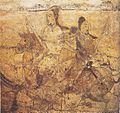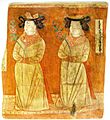Hufu facts for kids
Quick facts for kids Hufu |
|||||||
|---|---|---|---|---|---|---|---|
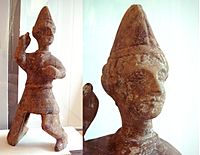
A foreign Sogdian soldier wearing a curved collar (曲领) short robe, Eastern Han, early 3rd century.
|
|||||||
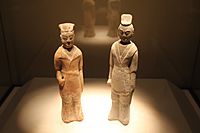
Figurines from Northern Wei.
On the left: Foreign fashion lapel robes On the right: Foreign-influenced or foreign-style cross-collared robes closing to the left side instead of the right side. Traditionally, Chinese style upper garment closes to the right. |
|||||||
| Chinese name | |||||||
| Chinese | 胡服 | ||||||
| Literal meaning | Babarian clothing | ||||||
|
|||||||
| Korean name | |||||||
| Hangul | 호복 | ||||||
| Hanja | 胡服 | ||||||
|
|||||||
Hufu (Chinese: 胡服; pinyin: húfú) is a general term for clothing worn by non-Han Chinese people in ancient China and nearby areas. It also means clothing from other countries or cultures that became popular in China. Hufu-style clothes started to appear in China around the time of King Wuling of Zhao.
Contents
- What Does 'Hufu' Mean?
- How Was Hufu Different from Hanfu?
- History of Hufu in China
- Types of Clothing Called Hufu
- Chinese Clothing Influenced by Hufu
- See also
- Images for kids
What Does 'Hufu' Mean?
The word 'Hu' was used to describe people who were not Han Chinese. This included northern nomadic groups like the Xiongnu, and people from western regions such as Sogdians, Sasanid Persians, Turkic people, Uyghurs, Tibetans, and Khitans. These groups lived in the northern and western parts of the ancient Chinese empire.
How Was Hufu Different from Hanfu?
The easiest way to tell Hufu apart from Hanfu (traditional Chinese clothing) was by looking at how the collar closed.
Chinese Collar Styles
Traditional Chinese clothing, like robes and jackets, usually closed to the right. This style is called youren (Chinese: 右衽). It started in the Shang dynasty and became an important symbol for the Han Chinese.
However, Chinese people did sometimes wear clothes that closed to the left, known as zuoren (Chinese: 左衽). This was usually for special occasions, like funerals. Ancient Chinese believed that the left side represented life (Yang) and the right side represented death (Yin). So, wearing clothes closed to the left was seen as dressing for the deceased. It was generally considered bad luck for living people to wear zuoren.
Even so, this rule wasn't always followed strictly. In some areas and times, like parts of northern Hebei in the 10th century or during the Ming dynasty, some Han Chinese people wore left-closing clothes.
Non-Chinese Collar Styles
Many non-Han Chinese groups, like the Xianbei and Khitans, often wore clothes that closed to the left (zuoren). Even Confucius talked about this, saying that if it weren't for a wise leader, the Chinese might have ended up wearing their hair loose and clothes closing to the left, like the "barbarians."
By the Han dynasty, the phrase pifa zuoren (simplified Chinese: 被发左衽; traditional Chinese: 被髮左衽, meaning "unbound hair and left lapel") became a common way to describe foreign people. It highlighted the differences between Han Chinese culture and other groups, showing who was considered "civilized" and who was not. So, zuoren became a clear sign of Hufu or foreign rule.
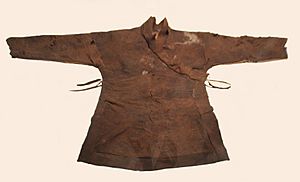
History of Hufu in China
Warring States Period
King Wuling's Hufu Policy
During the Warring States period, King Wuling of Zhao (who ruled from 326–298 BC) made a big change. He introduced the Hufuqishe (Chinese: 胡服騎射) policy, which meant adopting "Hu clothing and mounted archery." This was done to make it easier for his soldiers to ride horses and fight. The term 'Hufu' was created at this time, named after the 'Hu' nomadic people.
King Wuling's soldiers had to wear uniforms similar to those of the Donghu, Linhu, and Loufan people. This change from chariot warfare to cavalry showed the influence of the Xiongnu, a northern neighbor.
The Hufu adopted by King Wuling included trousers, a short shirt or jacket with tight sleeves, boots (xue), a belt, and a belt buckle. These clothes were designed for people who rode horses.
How Hufu Trousers Changed Chinese Clothing
Before King Wuling, Chinese people wore traditional clothes with upper garments and skirts. They also had early forms of trousers called ku (Chinese: 袴), which were more like knee-high leg coverings.
King Wuling introduced a different type of trousers called kun (Chinese: 裈). These trousers had a loose rise that covered the crotch. At first, these were mainly worn by soldiers and servants because they didn't fit traditional Han culture. However, the kun trousers influenced the development of Chinese trousers, making them longer and more enclosed at the waist. This led to new styles of trousers in later dynasties.
Han Dynasty
In the Eastern Han dynasty, some Hanfu styles started to show influences from the Hu people. Round-collar gowns began to appear, though they were often worn as undergarments.
Wei, Jin, Northern and Southern Dynasties
This was a time when different cultures mixed in China. Han Chinese in the south liked the riding clothes of northern groups, which included trousers and short, tight-sleeved robes. Northern nomads also brought in leather boots, a type of jacket called quekua (Chinese: 缺胯), and hood and cape outfits.
Xianbei Influence and Bans
During the Northern Wei dynasty, the Xianbei people introduced round-collar robes with tight sleeves, which were good for horse riding. These styles influenced Han Chinese robes. The Xianbei rulers adopted Chinese clothing and customs, and Han Chinese started to wear some Xianbei styles, like high boots and round-collar robes.
However, Emperor Xiaowen of Northern Wei later banned Hufu (northern barbarian clothing), including Xianbei clothes, as part of his plan to make his people more Chinese. Many Xianbei people adopted Han Chinese clothes, language, and customs. After the Northern Wei fell, Xianbei-style clothing for men reappeared in art, but not for women.
Sogdian Influence
The Sogdians, also called Hu in Chinese, were merchants who lived in China. They wore knee-length robes called yuanlingpao-like kaftans, which mixed their own style with Chinese and early Turkic influences. Their robes often had round collars that could be unbuttoned to form lapels. These lapel robes became very popular in northern China for both men and women, and their style continued into the Tang and Sui dynasties.
Tang Dynasty
The Tang dynasty was a time when Chinese culture openly accepted and blended with foreign cultures, including influences from Gandhara, Turkestan, Persia, and Greece. These styles mixed into Tang clothing. For example, women's clothing sometimes had low-cut necklines.
Popular Hufu Styles in Tang Dynasty
In the Tang dynasty, the round-collar jacket and gown, tied with a belt, became very popular for both men and women. It was even fashionable for women to dress like men.
Hufu from the Silk Road was also popular. This included jackets with open fronts and narrow sleeves, striped trousers, woven boots, and weimao (a wide-brimmed hat with a veil). Other Hufu headwear included the mili (a burqa-like head covering) and the humao (a veil-less hat).
Many paintings and figurines show female court attendants wearing men's Hufu. The yuanlingpao could be worn buttoned as a round-collar gown or unbuttoned to become a lapel robe, influenced by Sogdian styles. These lapel robes were considered Hufu and were very popular, especially during the time of Wu Zetian.
People also decorated their gowns with fabrics like brocade on the collars, sleeves, and front. This "partial decoration" was influenced by Sogdians.
Uyghur Clothing
After the An Lushan Rebellion (755 - 763 AD), it became fashionable for noble women to wear Huihuzhuang (回鶻装; Uyghur dress). These were turned-down lapel robes that were slim-fitting. However, after the Uyghur empire collapsed in 840 AD, all Uyghurs living in China had to wear Chinese-style clothing.
Hufu Fades in Tang Dynasty
After the peak of the Tang dynasty, the influence of Hufu slowly faded. Clothing styles became looser, and more traditional Han Chinese clothing was worn again.
Song, Liao, Western Xia, Jin Dynasties
The Jin dynasty was founded by the Jurchens. In 1126, the Jurchens ordered all Chinese people in conquered areas to shave their hair and wear only Jurchen style clothes. This was a way to show who was in charge.
However, this order wasn't always strictly followed. Later, under Emperor Hailing Wang, Chinese people were allowed to wear Chinese clothing again. Emperor Shizong of Jin even tried to stop Jurchens from adopting Chinese customs and clothing, as many were forgetting their own traditions. By 1170, Chinese men often wore Jurchen or mixed styles, but Chinese women, especially noblewomen, mostly kept their Han-style clothing.
Yuan Dynasty
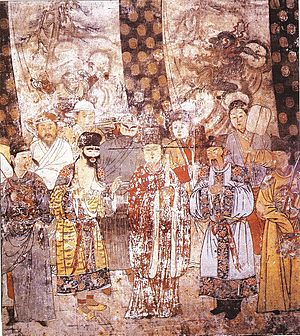
The Mongol rulers of the Yuan dynasty also influenced Chinese clothing. While Mongol clothing became popular, traditional Han Chinese clothing still existed. Men's casual clothes often followed Han Chinese styles, but noblewomen mainly wore Mongol clothing. Common women wore traditional Chinese skirts and short jackets. Mongol hats like the boli hat and robes like the terlig and jisün also influenced the Han Chinese.
Goryeo-style Clothing
Towards the end of the Yuan dynasty, clothing from Goryeo (ancient Korea) became popular among Mongol rulers and noblewomen in the capital. This fashion trend was called goryeoyang (高麗樣). It included a square-collared, short-sleeved upper garment. This style actually came from ancient Chinese costumes that had spread to Korea before the Yuan dynasty.
Ming Dynasty
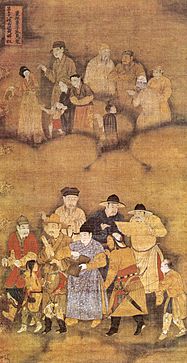
After the Yuan dynasty fell, the first Ming emperor ordered people to go back to Tang-style clothing. Later, there were several bans on wearing Hufu, especially for gentry women. Even so, some clothing styles influenced by Mongol fashion, like the yesa and dahu, continued to be used in the Ming dynasty.
Qing Dynasty
The Qing dynasty was ruled by the Manchu people, and their clothing style, Qizhuang, became dominant.
Types of Clothing Called Hufu
- Xiongnu clothing
- Xianbei clothing
- Sogdian clothing in China
- Maweiqun - a crinoline-like underskirt from Joseon (Korea)
- Yuan dynasty Mongol clothing: terlig
Chinese Clothing Influenced by Hufu
Many Chinese clothing styles were influenced by or adopted from Hufu, then changed to fit Hanfu traditions. These include:
- Robes: Yuanlingshan/ yuanlingpao (round-collar robes), panling lanshan, fanlingpao (lapel robe), jisün, yesa, dahu and tieli from the Ming dynasty.
- Outfits: Shanku (top and trousers), Tanling ruqun (skirt with a low-cut top).
- Upper garments: Ru (short jacket), Tanling banbi (short-sleeved top), bijia (sleeveless jacket).
- Headwear: wuguan, heguan (鶡冠), mili, Weimao (hat with veil), humao (veil-less hat), futou, damao (large hat).
See also
- Hanfu
- Paofu - Long Chinese robes
- Qizhuang - Manchu clothing
- Guan
Images for kids










